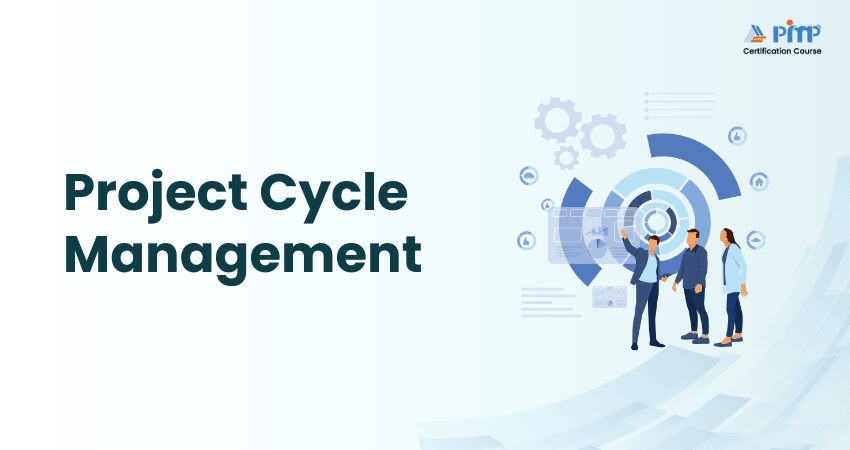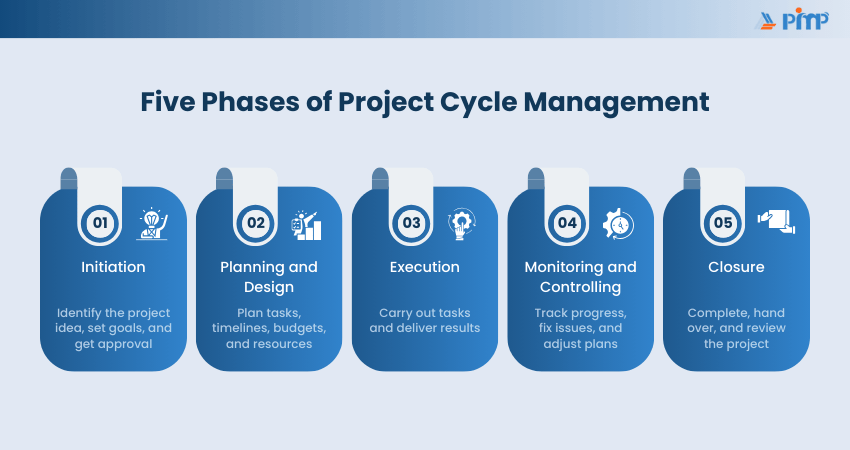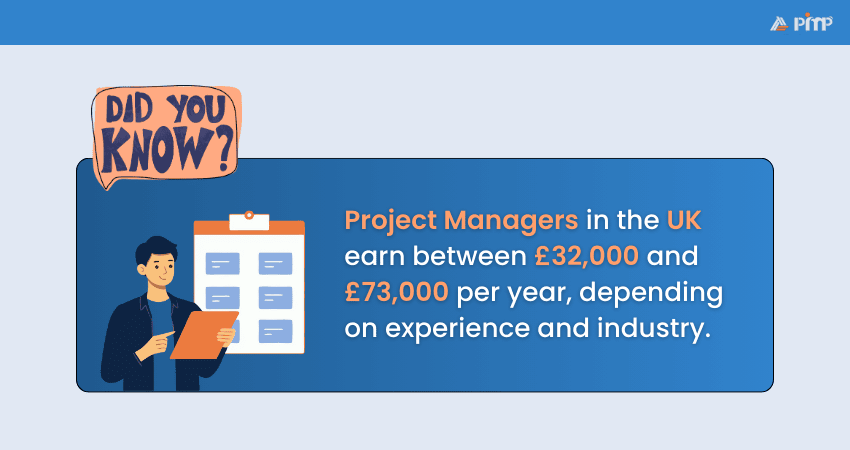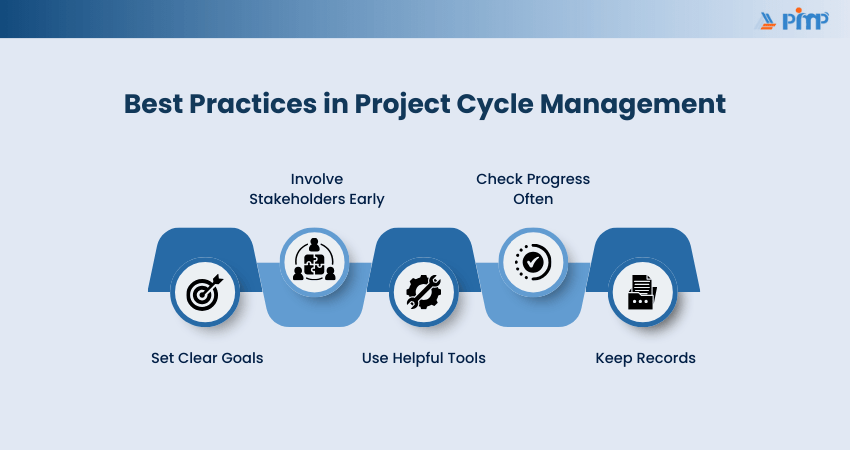







 10 Sep 2024
10 Sep 2024



Remember those college group projects where one person did all the work, another disappeared, and deadlines came crashing down? Managing real projects without structure feels the same. That’s where Project Cycle Management (PCM) saves the day. It gives teams clarity, direction, and a clear plan from start to finish.
In this blog, we’ll explore what Project Cycle Management is and its five key phases. We’ll also cover essential tools, who uses them, its benefits, challenges, and best practices to make your projects stress-free. Let’s get started!
Table of Contents
1) What is Project Cycle Management?
2) The Five Phases of Project Cycle Management
3) Tools for Project Cycle Management
4) Who Uses Project Cycle Management?
5) Benefits of Project Cycle Management
6) Challenges of Project Cycle Management
7) Best Practices in Project Cycle Management
8) Conclusion
Project Cycle Management is a structured framework for planning, organising, and managing projects from start to finish. Its goal is to deliver projects effectively by meeting objectives, satisfying stakeholders, and using the right resources at the right time.
To achieve this, PCM helps teams stay aligned, manage risks, and ensure accountability. This is accomplished through a continuous, iterative process that involves distinct stages like identification, planning, implementation, monitoring, and evaluation.
PCM consists of five main phases. Each phase builds on the previous one and prepares for the next.

This is the starting point of any project. At this stage, you find out why the project is needed, set clear goals, and decide if it should move forward. You also make sure the project matches the organization's needs and will be worth the effort.
Key Activities:
a) Identifying problems or opportunities
b) Setting project goals
c) Conducting feasibility studies
d) Getting approvals and stakeholder buy-in
Example:
A Non-governmental Organization (NGO) identifies that a rural village lacks clean drinking water. They decided to initiate a project to build a water purification system.
Once the project is accepted, detailed planning begins. Here, the project team decides how the work will be done, who will do it, and when it will be completed. They also plan the budget, list the needed resources, and prepare for possible problems. This stage makes sure everyone knows their roles and the project runs smoothly.
Key Activities:
a) Creating a detailed project plan
b) Setting timelines and milestones
c) Allocating resources and budgets
d) Assessing potential risks
e) Designing workflows and schedules
Example:
For the NGO’s water project, the team plans the budget, selects the purification technology, designs the system, and sets a six-month timeline.
This is where the actual work begins. The team starts implementing the project plan by carrying out activities and producing deliverables. Everyone follows the plan carefully to meet the project goals on time. Good teamwork and clear communication are very important at this stage.
Key Activities:
a) Assigning tasks to team members
b) Managing resources and suppliers
c) Ensuring quality in deliverables
d) Maintaining effective communication among stakeholders
Example:
The NGO installs the water purification system, hires workers, and ensures everything is built according to the design.
This phase runs alongside execution. It means checking the project’s progress to make sure everything is going as planned. You ensure the work is on time, within budget, and meets the required quality. If any problems come up, they are fixed quickly to avoid delays.
Key Activities:
a) Measuring performance using Key Performance Indicators (KPIs)
b) Identifying and resolving issues quickly
c) Updating stakeholders regularly
d) Adjusting plans if necessary
Example:
The NGO monitors the installation process, ensures safety guidelines are followed, and resolves any technical problems immediately.
This is the final stage where the project is completed and handed over to stakeholders. The team reviews the whole project to see what went well and what can be improved. Lessons learned are recorded to make future projects easier and more successful.
Key Activities:
a) Reviewing project outcomes
b) Preparing final reports
c) Delivering completed outputs to stakeholders
d) Conducting post-project evaluations
e) Celebrating achievements and recognizing contributions
Example:
The NGO hands over the water purification system to the village authorities and documents insights for future projects.
Secure your foundation in Project Management. Join our PMI Project Management Ready® Certification now
Tools for Project Cycle Management are software, apps, or platforms that help plan, organize, track, and manage projects more effectively. They make it easier to create schedules, assign tasks, monitor progress, manage budgets, and collaborate with teams.
Here are some commonly used tools:
1) Microsoft Project: Helps plan timelines, allocate resources, and track progress.
2) Trello: Uses boards and cards to manage tasks visually
3) Asana: Good for team collaboration and project tracking
4) Jira: Ideal for Agile projects and issue tracking
5) Wrike: Useful for automating workflows and generating reports
These tools save time, reduce errors, and make sure everyone remains on the same page throughout the project lifecycle.
Project Cycle Management is widely used by various organizations across industries. Here are the most common users:

NGOs use Project Cycle Management to plan and manage projects like education programs, healthcare services, and environmental campaigns. It helps them use donor money carefully and make sure it reaches the right people. PCM also makes it easy to show donors how their money is used.
Donor organizations and funding bodies give money for projects run by NGOs or governments. They use PCM to check how the money is spent and make sure it is used properly. It also helps them see if the project is successful and meeting its goals. This builds trust between donors and the organizations managing the projects.
Governments use PCM to manage big projects like building roads, schools, hospitals, and running welfare programs. It helps them plan better, spend budgets wisely, and finish work on time. PCM also makes sure the projects benefit the right people. It improves transparency and ensures government resources are used effectively.
Private sector organizations use PCM to manage business projects, product launches, system implementations, and organizational changes. It helps them deliver projects on time, within budget, and according to quality standards.
Organizations like the World Bank, UN agencies, and bilateral aid organizations use PCM to manage large-scale development programs across multiple countries. It helps standardize project approaches and improve accountability.
Project Cycle Management offers several advantages that make it essential for project success.
PCM makes sure every project supports the organization's main goals and long-term plans. This avoids wasting time, money, and effort on work that doesn’t matter. It also helps teams focus only on important tasks that bring real value to the organization.
PCM involves stakeholders, people affected by the project, at every stage. This builds trust and makes sure everyone agrees on what needs to be done. It also improves teamwork and communication, helping avoid confusion and misunderstandings.
PCM works in clear steps, making it easier to handle changes during the project. If new challenges come up, plans can be updated quickly without affecting the whole project. This flexibility helps teams adapt and achieve better results.
Build Business Analysis expertise with our PMI-PBA® Certification – Join now!
While PCM is effective, it also comes with certain challenges. Here they are:
When many people are involved in a project, miscommunication can happen easily. This can cause confusion, delays, and mistakes in the work. Clear and open communication is very important to keep everyone on the same page.
Solution: Use regular meetings, updates, and collaboration tools to keep everyone informed.
Sometimes, new ideas or tasks get added to the project after it has already started. This is called scope creep, and it may lead to higher costs, extra work, and missed deadlines. Setting boundaries early helps keep the project focused and manageable.
Solution: Set clear objectives and manage changes through a structured approval process.
Projects often face limited budgets, fewer workers, or a shortage of materials. These resource issues can slow down progress and affect project quality. Planning ahead helps avoid sudden shortages or delays.
Solution: Proper planning, risk assessment, and resource allocation can help avoid major disruptions.
Best practices in Project Cycle Management are easy tips that help you manage projects better and get good results. They make sure your project stays well-organized, on time, and within budget.

Here are some simple best practices:
1) Set Clear Goals: Decide exactly what your requirement is to achieve before starting.
2) Involve Stakeholders Early: Include everyone affected by the project to avoid confusion.
3) Use Helpful Tools: Choose software to plan tasks, track progress, and work together easily.
4) Check Progress Often: Keep an eye on timelines, costs, and tasks to prevent delays.
5) Keep Records: Note what worked well and what didn’t to improve future projects.
Project Cycle Management is a structured and effective way to plan, execute, and deliver successful projects. By breaking the process into clear stages, involving stakeholders, and using the right tools, organizations can achieve better outcomes. Whether you are part of an NGO, government body, or donor organization, PCM helps ensure your projects run smoothly and deliver meaningful results.
Boost your career, learn advanced project scheduling with our PMI Scheduling Professional (PMI-SP)® Certification – Join now!






© Copyright 2025. All rights reserved. Contact: PMP® TRAINING ACADEMY.


